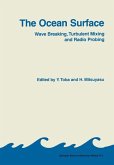1: Tidal Potential.- 1.1. The Tide-Generating Forces in the Ocean.- 1.2. Tidal Potential.- 1.3. Harmonic Analysis of the Tidal Potential.- 1.4. Additional Potentials of Deformation.- 2: Methods and Results of Experimental Studies of Ocean Tides.- 2.1. Direct Measurements of Tidal Elevations.- 2.1.1. Semidiurnal Tides.- 2.1.2. Diurnal Tides.- 2.1.3. Long-Period Tides.- 2.1.4. The Nature of the Ocean¿s Response to External Action.- 2.2. Satellite Data.- 2.3. Determination of Ocean Tides from Gravimetric Data.- 3: Qualitative Studies of the Tidal Dynamics Equations.- 3.1. Tidal Dynamics Equations.- 3.2. Simplification of the Tidal Dynamics Equations, Boundary Conditions.- 3.3. Basic Notions and Definitions.- 3.4. Uniqueness Theorem.- 3.5. A Priori Estimates.- 3.6. Existence Theorem.- 3.7. Solvability of the Three-Dimensional Boundary Value Problem of Tidal Dynamics: Homogeneous Ocean.- 3.8. Solvability of the Three-Dimensional Boundary Value Problem of Tidal Dynamics: Stratified Ocean.- 3.9. Asymptotic Behavior of the Solution of Tidal Dynamics Equations when t ? ?.- 4: Free Oscillations in the World Ocean.- 4.1. Rayleigh¿s Ratio.- 4.2. Analytical Solutions.- 4.2.1. Spherical Ocean of Constant Depth.- 4.2.2. Ocean Bounded by Two Meridians.- 4.2.3. A Flat Basin.- 4.3. Numerical Solutions.- 4.3.1. Proudman¿s Method.- 4.3.2. Finite Difference Method.- 4.3.3. Results.- 4.4. Elementary Modes of Free Oscillations.- 4.4.1. Sverdrup Waves.- 4.4.2. Kelvin Waves.- 4.4.3. Poincar¿aves.- 5: Forced Tidal Oscillations in the World Ocean.- 5.1. Analytical Solutions.- 5.2. Numerical Solutions.- 5.2.1. The Semi-Emperical Approach.- 5.2.2. The Theoretical Approach.- 5.2.3. Semidiurnal Tides.- 5.2.4. Diurnal Tides.- 5.2.5. Long-Period Tides.- 5.3. Numerical Experiments.- 5.3.1. Tides in the World Ocean of Real Configuration.- 5.3.2. Tides in the World Ocean of Idealized Configuration.- 5.3.3. Tides in the Oceans Separated by Barriers.- 5.3.4. Tides in the World Ocean in the Absence of the Earth¿s Rotation.- 6: Tides in the Ocean-Shelf System.- 6.1. Preliminary Remarks.- 6.2. The Existing Methods of Shelf-Effect Parameterization.- 6.2.1. Local Methods of Parameterization.- 6.2.2. Integral Approaches to Parameterization.- 6.3. The Influence of Shelf Effects on the Tides in an Idealized Ocean.- 6.4. The Influence of Shelf Effects on the Tides in the World Ocean.- 7: Global Interaction of Ocean and Terrestrial Tides.- 7.1. Solvability Conditions of the Problem.- 7.2. Difference Methods of Solution.- 7.3. Results of Numerical Experiments.- 7.3.1. Ocean Tides.- 7.3.2. Terrestrial Tides.- 7.3.3. Tidal Variations of Gravity.- 8: Energetics of Ocean Tides.- 8.1. Energy Equation.- 8.2. Astronomical, Geophysical, and Satellite Estimations of Tidal Energy Dissipation.- 8.2.1. Astronomical Estimations.- 8.2.2. Geophysical Estimations.- 8.2.3. Satellite Estimations.- 8.3. The Problem of Tidal Energy Dissipation in the Ocean-Earth System.- 8.4. Tidal Energy Dissipation in the Paleoocean.- 9: Bottom Boundary Layer in Tidal Flow: Experimental Data.- 9.1. Motion Regime in the Bottom Boundary Layer.- 9.1.1. The Method of Small Perturbations.- 9.1.2. The Energy Method.- 9.2. Hydrodynamic Properties of the Sea Bottom.- 9.3. Mean Velocity Profiles.- 9.4. Statistical Characteristics of Turbulent Fluctuations.- 9.5. Unidimensional and Co-Spectra of Velocity Fluctuations, Reynolds Stress.- 9.6. Similarity of Turbulence Structures in Boundary Layers of Different Origin.- 10: Bottom Boundary Layer in Tidal Flow: Theoretical Models.- 10.1. Qualitative Considerations Regarding the Vertical Distribution of the Tidal Velocity in the Bottom Boundary Layer.- 10.2. Bottom Boundary Layer Models Based on A Priori Assignment of the Vertical Turbulent Viscosity Coefficient.- 10.3. Bottom Boundary Layer Models Based on the Closure of Equations with the Help of Semi-Emperical Hypotheses.- 10.3.1. Bottom Boundary Layer with Neutral Stratification.- 10.3.2. Stratified Bottom Boundary Layer.- 10.4. The Resistance Law in Tidal Flow.- 10.4.1. Jonsson¿s Solution.- 10.4.2. Kajiura¿s Solution.- 10.4.3. Kagan¿s Solutions.- References.








